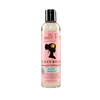What's inside
What's inside
 Key Ingredients
Key Ingredients

 Benefits
Benefits

 Concerns
Concerns

 Ingredients Side-by-side
Ingredients Side-by-side

Water
Skin ConditioningCocamidopropyl Betaine
CleansingGlycerin
HumectantSodium Lauroyl Isethionate
CleansingSodium Chloride
MaskingButyrospermum Parkii Butter
Skin ConditioningVitis Vinifera Seed Oil
EmollientMelaleuca Alternifolia Leaf Oil
AntioxidantHelianthus Annuus Seed Oil
EmollientPanthenol
Skin ConditioningCoconut Acid
CleansingPolyquaternium-10
Guar Hydroxypropyltrimonium Chloride
Skin ConditioningStearamidopropyl Dimethylamine
EmulsifyingMenthol
MaskingSodium Methyl Cocoyl Taurate
CleansingCitric Acid
BufferingCaprylic Acid
CleansingCapric Acid
CleansingLauric Acid
CleansingSodium Isethionate
CleansingSodium Methyltaurate
Skin ConditioningSodium Acetate
BufferingPotassium Sorbate
PreservativeSodium Phytate
Sodium Benzoate
MaskingCaprylyl Glycol
EmollientParfum
MaskingWater, Cocamidopropyl Betaine, Glycerin, Sodium Lauroyl Isethionate, Sodium Chloride, Butyrospermum Parkii Butter, Vitis Vinifera Seed Oil, Melaleuca Alternifolia Leaf Oil, Helianthus Annuus Seed Oil, Panthenol, Coconut Acid, Polyquaternium-10, Guar Hydroxypropyltrimonium Chloride, Stearamidopropyl Dimethylamine, Menthol, Sodium Methyl Cocoyl Taurate, Citric Acid, Caprylic Acid, Capric Acid, Lauric Acid, Sodium Isethionate, Sodium Methyltaurate, Sodium Acetate, Potassium Sorbate, Sodium Phytate, Sodium Benzoate, Caprylyl Glycol, Parfum
 Reviews
Reviews

Ingredients Explained
These ingredients are found in both products.
Ingredients higher up in an ingredient list are typically present in a larger amount.
This ingredient is derived from guar gum.
It is a conditioning ingredient, meaning it helps soften skin and hair.
Parfum is a catch-all term for an ingredient or more that is used to give a scent to products.
Also called "fragrance", this ingredient can be a blend of hundreds of chemicals or plant oils. This means every product with "fragrance" or "parfum" in the ingredients list is a different mixture.
For instance, Habanolide is a proprietary trade name for a specific aroma chemical. When used as a fragrance ingredient in cosmetics, most aroma chemicals fall under the broad labeling category of “FRAGRANCE” or “PARFUM” according to EU and US regulations.
The term 'parfum' or 'fragrance' is not regulated in many countries. In many cases, it is up to the brand to define this term.
For instance, many brands choose to label themselves as "fragrance-free" because they are not using synthetic fragrances. However, their products may still contain ingredients such as essential oils that are considered a fragrance by INCI standards.
One example is Calendula flower extract. Calendula is an essential oil that still imparts a scent or 'fragrance'.
Depending on the blend, the ingredients in the mixture can cause allergies and sensitivities on the skin. Some ingredients that are known EU allergens include linalool and citronellol.
Parfum can also be used to mask or cover an unpleasant scent.
The bottom line is: not all fragrances/parfum/ingredients are created equally. If you are worried about fragrances, we recommend taking a closer look at an ingredient. And of course, we always recommend speaking with a professional.
Learn more about ParfumWater. It's the most common cosmetic ingredient of all. You'll usually see it at the top of ingredient lists, meaning that it makes up the largest part of the product.
So why is it so popular? Water most often acts as a solvent - this means that it helps dissolve other ingredients into the formulation.
You'll also recognize water as that liquid we all need to stay alive. If you see this, drink a glass of water. Stay hydrated!
Learn more about Water